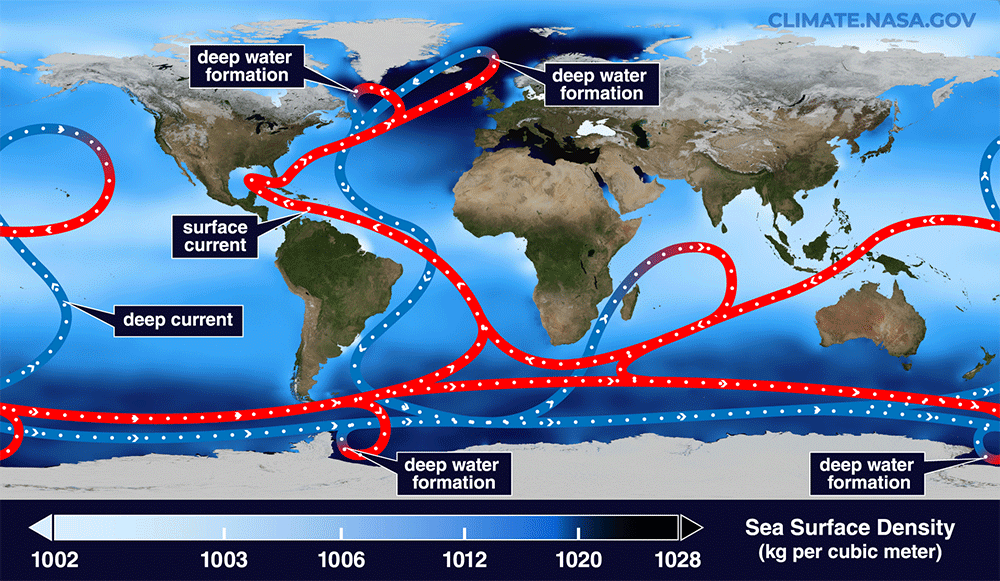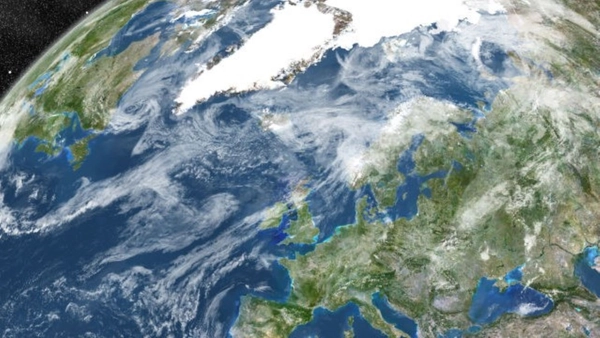Scientists have pinpointed the ocean engine with the biggest role in driving key Atlantic currents that regulate Earth’s climate, new research suggests.
The Irminger Sea off southeastern Greenland is where warm waters that transport heat northwards from the Southern Hemisphere sink and then return south along the bottom of the ocean. As such, this region plays a critical role in powering the ocean conveyor belt known as the Atlantic Meridional Overturning Circulation (AMOC).
“The key finding of this study is that the Irminger Basin (eastern Greenland) plays a crucial role in driving changes in the AMOC, a conclusion supported by recent observations,” study lead author Qiyun Ma, a postdoctoral researcher at the Alfred Wegener Institute for Polar and Marine Research in Germany, told Live Science in an email. The work highlights the urgent need for better monitoring in this particular location, he said.
The AMOC, which includes the Gulf Stream, maintains a temperate climate in the Northern Hemisphere and regulates weather patterns across the globe. But due to climate change, the AMOC may not keep temperatures stable for much longer.
Research shows that Arctic meltwater gushing into the North Atlantic is reducing the density of surface waters and preventing them from sinking to form bottom currents, thus slowing the machine that powers the AMOC.
And it turns out the Irminger Sea is particularly important for keeping these bottom currents flowing.
“Freshwater release in this region not only directly inhibits deep-water formation — essential for maintaining the strength of the AMOC — but also alters atmospheric circulation patterns,” Ma said. A reduction in the amount of water sinking in the Irminger Sea likely has greater impacts on the global climate than reductions of the same kind in other northern seas, Ma said.
The Irminger Sea has a disproportionate influence on the strength of the AMOC because it regulates the amount of water sinking to form deep currents in nearby seas through atmospheric processes, Ma said. Freshwater input into the Irminger Sea enhances freshwater flow into the Labrador Sea between southwestern Greenland and the coast of Canada, for example, so a reduction in deep-current formation in the Irminger Sea has knock-on effects for deep-current formation across the entire North Atlantic.
Ma and his colleagues examined the impact of meltwater on the AMOC using a climate model that simulated an increase in freshwater input in four regions — the Irminger Sea, the Labrador Sea, the Nordic Seas and the Northeast Atlantic. The researchers were able to tease out the sensitivity of the AMOC to meltwater in each region, then identified specific changes in the global climate linked to each scenario. The team published its findings Wednesday (Nov. 20) in the journal Science Advances.
The role of the Irminger Sea for the AMOC outweighed that of the three other regions in the model and triggered stronger climate responses. Reduced deep-water formation led to widespread cooling in the Northern Hemisphere, as well as Arctic sea ice expansion, because warm water wasn’t being brought up from the south.
The simulation also showed slight warming in the Southern Hemisphere and bolstered previous findings that a weaker AMOC would throw tropical monsoon systems into chaos.
The model confirmed findings from previous research, but it also held surprises, Ma said. Hidden within hemisphere-scale climate shifts, the researchers discovered climate extremes at much more localized scales. These included seasonal extremes in precipitation across North America and the Amazon Basin that varied depending on which region of the North Atlantic meltwater was added into.
“While the general climate impacts … were broadly anticipated, the behavior of climate extremes was not,” Ma said. Incorporating these extremes into climate models and recognizing that the location of meltwater input matters could help scientists better predict the impacts of a weakened AMOC, he said.
Forecasting AMOC behavior is becoming increasingly urgent as scientists warn we are nearing a tipping point. “These insights are critical for informing policy makers and climate experts in developing targeted strategies to mitigate and adapt to climate impacts,” Ma said.






